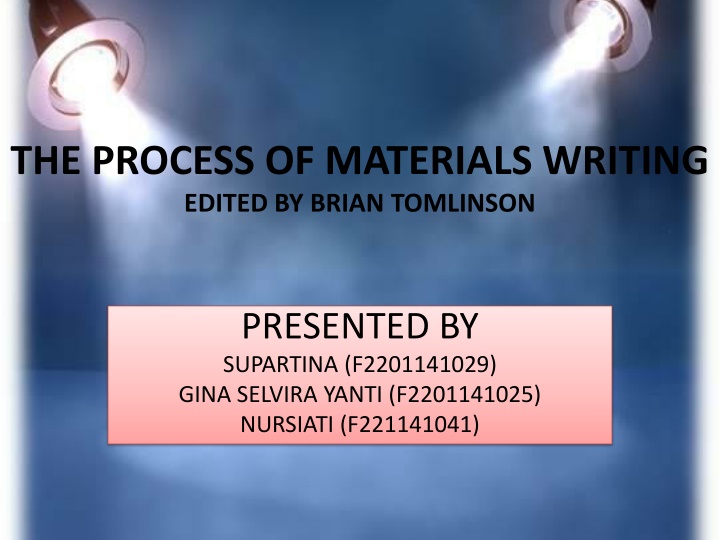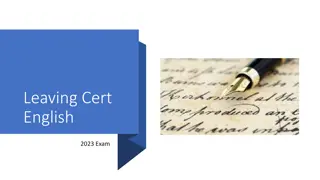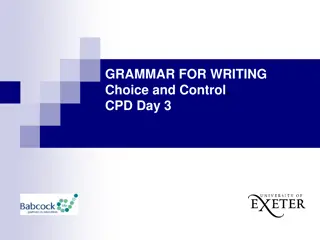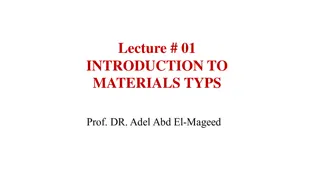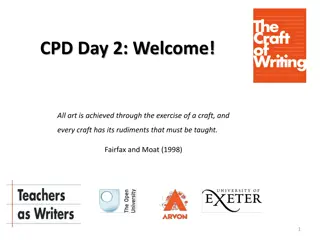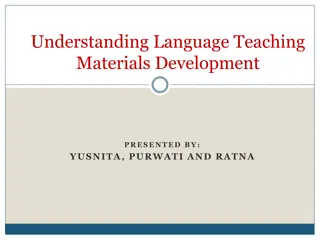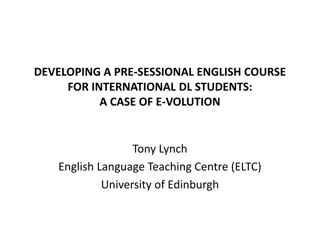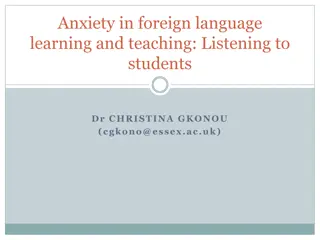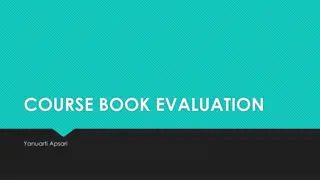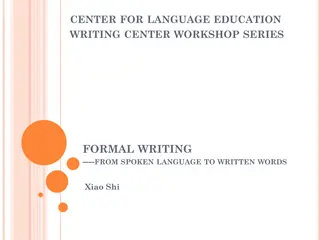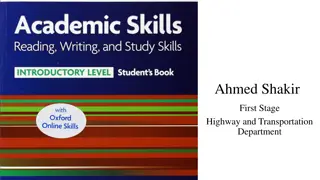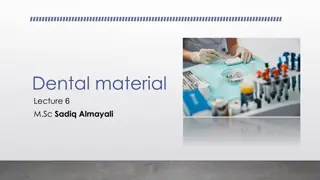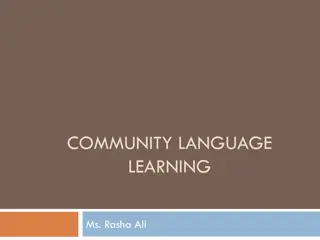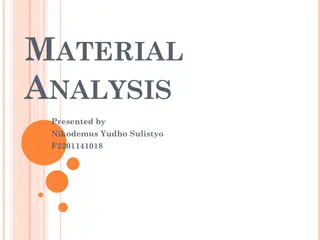Issues and Insights in Materials Writing for Language Learning
Problems and perspectives in materials writing for language learning are explored through the lens of educators and learners, highlighting challenges and cultural considerations in creating effective language resources. From addressing real-world language needs to navigating cultural nuances, the process of materials writing is examined with a critical eye towards authenticity and relevance in language education.
Download Presentation

Please find below an Image/Link to download the presentation.
The content on the website is provided AS IS for your information and personal use only. It may not be sold, licensed, or shared on other websites without obtaining consent from the author.If you encounter any issues during the download, it is possible that the publisher has removed the file from their server.
You are allowed to download the files provided on this website for personal or commercial use, subject to the condition that they are used lawfully. All files are the property of their respective owners.
The content on the website is provided AS IS for your information and personal use only. It may not be sold, licensed, or shared on other websites without obtaining consent from the author.
E N D
Presentation Transcript
THE PROCESS OF MATERIALS WRITING EDITED BY BRIAN TOMLINSON PRESENTED BY SUPARTINA (F2201141029) GINA SELVIRA YANTI (F2201141025) NURSIATI (F221141041)
The problems and few terms related to the materials writing and textbook I have noticed that the coursebook I use doesn t seem to deal with real English ( Italian secondary school teacher) My demand is becoming a reporter of the English football and I need, so, much familiarity .( Danish upper- intermediate student on a full-time intensive course in a British) IDENTIFICATION
CONTS... The textbook my institute has written says that you use please and would for simple request and would you mind for more polite request. I have heard lots of other things such as could you possibly (Croatian evening institute teacher) I get very confused with all these noughts and zeros and nothings in your language (Argentinean part-time student on a low intensity course in Britain EXPLORATION
CONTS... It s a very nice book and very lively, but in the section on the processes for the example all the exercises are about unusual things for our country. We are hot country and also have many Muslims. The exercises are about snow, ice, cold mornings, water cisterns; writing and publishing EFL books and making wine. I can tell you I can t do making wine and smoking pot in my country!(experienced school teacher from the Ivory Coast) Previous materials were not based on life on Brazil which is why I don t think they worked very well .(Brazilian teacher of English in school) CONTEXTUAL REALISATION
CONTS... Pair 1 A: his wallet must have fallen down the trolley . B : he must have forgotten it there.. C : perhaps he left it on the shopping trolley . D: perhaps he left it on car E : No, perhaps he drop it in the cleaner s PEDAGOGICAL REALISATION
The process of the materials writing IDENTIFICATION by teacher or learners of a need to fulfilll or a problem to solve by the creation of materials EXPLORATION of the area of need/problem in terms what language, what meanings, what functions, what skills CONTEXTUAL REALISATION of the purposed new materials by the finding of suitable ideas, contexts or texts with which to work PEDAGOGICAL REALISATION of materials by the finding of appropriate exercises and activities AND the writing of appropriate instruction s for use PHYSICAL PRODUCTION materials, involving consideration of layout, type size, visuals, reproduction, tape length.
Conclusion Materials writing is at its most effective when it is turned to the needs of a particular group of learners. Teachers understand their own learners best All teacher need a grounding in materials writing All teachers teach themselves Trialing and evaluation are vital to the success of any materials
1.If one of your pedagogic principles is that creativity is important in the classroom, then how can you make sure that your coursebook does not take away investment in and responsibility for learning from teachers and learners? 2.If coursebooks are sometimes used by schools to maintain consistency of syllabus, how can you at the same time make sure they reflect the dynamic and interactive nature of the learning process?
CONT... 3. Although it is true no coursebook can cater for all individual needs of all learners all of the time, can you provide enough material to meet most of the needs most of the time and build in enough flexibility to enable teachers to individualise it? 4. If the language presented in coursebooks includes few genuine example of authentic or corpus-based material, how can you ensure that your samples of use are as natural as possible? 5. If coursebooks are frequently predictable in format and content, how can you bring to your material a feeling that is not boring?
A.1. The notion of compromise Coursebooks are tools which only have life and meaning when there is a teacher present. It is important to choose the coursebooks that appropriate to the learners and the context, at least in the eyes of the school.
A.2. The publishers compromise Compromise is not something that is shared by users, publishers also compromise. The sensible balance a compromise of principle will surely be beetween innovation and conservatism, a blend of the new and different with the reasurringly familiar. The sales of the coursebook will be long-run published as long as the potential users use it.
A.3. The authors Teachers who are authors have to compromise; they have to beware of being too much the teacher trainer and look also at what students want. Authors who are not teachers have to compromise; whilst there are writing skills which not all teachers have such as structuring a sequence of activities and balancing it with usable visual.
B. A Case Study Intermediate level course for adult students both in UK and in private schools overseas. The assumption was that teachers would have experience in setting up communicative actitvities in the class.
CONT... The brief compromises: The multilingual intensive UK situation and the monolingual far less intensive situation are. Monoligual situations differ. Europe vs Asian. The material was still likely to be used by less trained, untrained or differently trained teachers. Who are the learners? The age of the learners need to be considered. It was likely that the materials would be used in some schools.
B.1. Principles Flexibility Teachers could move activities around, cut them out or supplement them according to need. From text to language Because of the needs of intermediate students, we wanted to provide authentic texts which contained examples of the focus language. Engaging content The author concluded that the main criteria for the texts were that they should be generative in terms of language and would motivative students to want to talk or write.
CONTS... Natural language Old language which had already been presented to them at lower levels would at intermediate level be embedded in new and natural langugae from native speakers communicating naturally. Analytic approaches The authors placed the importance on students working things out for themselves. Emphasiss on review The authors felt the need to review rather than present a lot of grammar at this level.
CONTS... Personalised practice The authors tried to provide a lot of practice activities at this level which is the activities draw students own experiences. Integrated skills By integrating the skills as far as possible, the authors are able to link speaking and writing with what the students had read o listened to, therefore providing a context and reason for communication. Balance of approaches In general, the authors would provide opportunities for both controlled practice and creative expression so that all learning styles were catered for as far as possible.
CONTS... Learning to learn it is important to integrate learner development work throughout rather than make it up-front training. In this principle, the learners will be able to develop their learning as time pass by. Professional respect Professional satisfaction and was academically credibel to our colleagues.
B.2. Pressures The publishers the authors felt that the publisher gave more attention to the flick test , not to its long-term usability. Schools and institutions They want the book to be the right length, had many units, the syllabus had to include the grammatical item. Teachers the materials had to be pedagogic, usable, fun activities. Students They want material that they could enjoy and comprehensible.
B.3. Principles compromised Overall structure the authors felt that the material ended up being less flexibly organised than they would have liked. Methodology They failed to present enough authentic materials at the intermediate level, partly because of the difficulty of finding texts. Texts the authors wanted the materials to be natural and as authentic as possible.
CONTS... Content In terms of content, they realised they could not please everyone. They did compromise to not use taboo subjects. Piloting Testing the materials is limited because of the time and budget.
Conclusion Compromised almost by definition is a subtle art if all sides are to satisfied with getting less than they originally wanted, and it has not always been possible to tease out and identify all the compromises that were made when and by whom. Without certain compromises the authors would have produced less effective materials.
This chapter looks at the process of materials writing from the writer s perspective. It uses two snapshots: one taken in 1994 and one taken 15 years later.
A. Writers Perspectives in 1994 A.1. Working together - Most of the contributors have written at some time, or always, as a member of a team. Writing teams are often put together by publishers and considerable getting to know you needs to take place before writing can start. - The mode of working we ve agreed on is the following: - During a first workshop: the group decides on topics, functions, skills focus, treatment of grammar, vocabulary, format of a unit and a lesson. Then units are allocate to each member.
CONTS... devise units accordingly. - In about three months the group meets again with the project coordinator and the consultants and common agreement for all lessons is obtained. - Writers go back to their hometown and
CONTS... - My colleague and I decide on the topic to work on and we get together in the same room ad try to find appropriate materials and ideas (in our library). We also bring materials from home and the bookstore, pool it and then disperse to get acitivities prepared. Then we come together again, order out parts, decide together about order and usefulness, and after trying things out we reverse them (each looks at other s part). Then our colleagues try the material out and give us feedback.
CONTS... - I have had negative experiences in working with co- authors who are virtual strangers and who are representing the country for which the book is intented. This is often relationship full of stresses and strains which result from approaching the project from totally different angels. Then changes made to a manuscript are often guided by motives unconnected to pedagogical considerations
CONTS... How to work together is clearly something which occupies materials writers. In the accounts given here we can distinguish pairs who work closely together, pairs who complement each other, and larger teams where management of the writing process becomes as important as the writing itself.
C. Working with publishers The steps done between authors and co-author: Initial stage - Research on new level what is needed/gaps in market/weaknesses of other materials by talking to teachers (students sometimes). This step done independently with following up meetings/sharing opinions and findings. - Meeting with co-author (at home) to discuss and draft ourbasic rationale. - Creation of draft unit (usualyy Unit I). Planning of unit usually done together. - Submit rational/draft unit/propsed grammar syllabus to publisher.
B. The creative process - When I feel inspired the writing comes easily, but when the first idea has been put on paper I tend to lose interest. I nevertheless want to work to be mine , and get tense when my co-author seems less committed to the storyline and the relationships between the characters than I am .
CONTS... - Sometimes it s hard to stop writing. Carrying on into the night - long after you re past your best and you seem to be working on auto-pilot can bring on insomnia and reduced efficiency the day after. Meals get postponed, as does time with the family and with friends. Most of the writers quoted here appear to rely heavily on their own institutions, viewing textbook writing in the same way as writing fiction, whilst at the same time emphasising the constraints of the syllabus. The unstated assumption is that the syllabus precedes the creation.
CONTS... - Meanwhile stage - The author continue to buidl up ideas for other syllabuses vocabulary , writing, pron., etc. In terms of activity types and topic. They also build up a bank of authentic texts which we feel we can use or adapt. - There is often a meeting with the designer and art editor at this stage to discuss the look we want from the book. - When reports come back on draft unit and rationale there is meeting with the publisher and project manager, to share views and take astand on what changes.
CONTS... These following are the next steps: - First draft The authors sent the draft to readers and the feedback is following up with a mega-meeting with publishers. - Second draft This is usually takes a long time period involving quite a lot of change. - Third draft At this point the publishing team are very involved, and as we are writing, finished units will be copy-edited and sent bakc to us. And there are also meeting with designers and editors. - Finally it takes, on average, six months of non-stop follow-up production work, particulary in the area of design, cuts and rubrics.
CONTS... the writers refers to the publishing team which may typically consists of a publisher in overall charge, a commisioning editor, designer and readers.
D. Designers and Illustrators Whilst a number of the contributors complained of lack of involvement with the design of their books, the account which follows accurately reflects the current awareness of the importance of design. The are sometimes problems with the artbriefs for illustrators. These come from two sources: 1. My maxim illustrators: any one illustrator can either read or draw. 2. Suspension of Gricean maxims.
F. A time and a place to write Another reasurringly divergent set of views, this time on when and where to write: Usually when the kids are away. I need to complete peace when I write. Distractions break my flow of ideas . I usually write in my study, at the desk, by the window. My bulldog always comes to sleep and snore near me when I work. I can never work at night; my most efficient time is morning.
Conclusion What does come through strongly in the range of views presented here in the apparent centrality of writing to the contributors lives, and the seriousness with which they take it. It is to be hoped that the above accounts will strike chords with other writers around the world, and lead to a little more understanding between writers and publishers.
REFLECTIONS 15 YEARS LATER There has been change in the predictable area of technology, the creative and cooperative aspects of materials writing appear timeless.
7.9.1 The influence of the market Mares (2003) says when writing, do not write for yourself. Remember what you are writing for a market. You need to know the market, which means getting as much as information as you can about the market and writing for that market . From Philip s experience, he does his coursebook project by doing repeated visits to the market whilst project is under development and during the writing process.
7.9.2 The ELT writer and technology The life of ELT writer has been transformed due to advances in technology in general, and educational technology in particular. Today s author can look up thousands of words in context using a concodancer; he or she can tap into vast source of knowledge on the World Wide Web, copy and paste text, refine and repurpose it.
7.9.3 Using the internet By using the internet, the authors can find more sources as the inspiration on every topic imaginable. The text can be copied into a Word document; the authors can select some sources online if it is appropriate with his/her purpose.
7.9.4 Writing together Based on Philip s experience, he says working face to face is essential for initial planning, brainstorming, creative phrases as well as for discussion of material and reviewing. But new technology (and not so new, the telephone) can mean that authors can virtually in the same room whilst in different parts of the country or globe.
